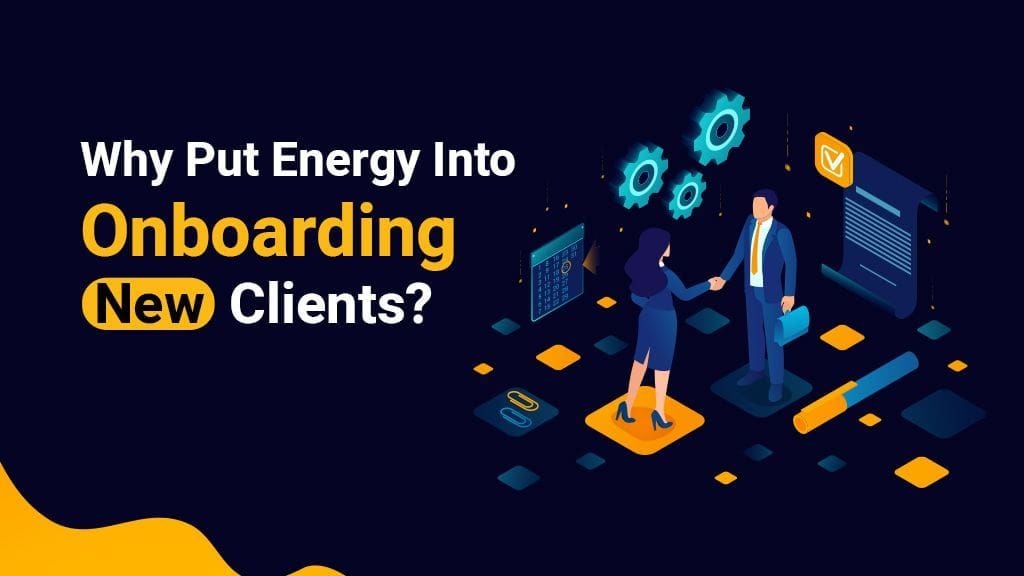Why Put Energy Into Onboarding New Clients?
)
The critical importance of a positive onboarding experience for customer retention and loyalty is starkly highlighted by revealing statistics: 76% of customers with a welcoming onboarding experience are inclined to continue their patronage. This significant insight underscores the necessity for businesses to invest in an effective onboarding process, as it directly influences long-term customer engagement.
Furthermore, the data suggests that well-executed onboarding can boost customer retention by up to 50%. This compelling evidence underlines the substantial impact that a refined onboarding strategy can have on a business's success, emphasising the value of dedicating resources towards enhancing the customer onboarding journey to secure customer satisfaction and loyalty in a competitive market landscape.
Investing significant time, money, and effort in acquiring new clients underscores the importance of maximising this investment by enhancing their onboarding experience. By doing so, businesses not only extend the duration of client engagement but also increase the likelihood of additional purchases and referrals. Surprisingly, 90% of businesses overlook this crucial aspect, which yields considerable rewards. Prioritising an exceptional onboarding process is a strategic move that can set a business apart, ensuring a higher return on the initial customer acquisition investment. Especially if you use a tool that can automate most of this process - where you do it once and it keeps on and on giving the results.
Maximising Client Onboarding Efficiency with Automated Email Marketing
Using emails to onboard new clients is a strategy full of benefits, particularly due to its efficiency and effectiveness in engaging customers. Email marketing, when utilised as the backbone of your onboarding process, offers a seamless, automated approach that continues to deliver value without requiring constant effort. This automation allows businesses to set up a series of informative, welcoming emails once and then benefit from this system working tirelessly in the background, onboarding new clients time and again.
The effectiveness of email as a tool for onboarding should not be underestimated. Statistics show that onboarding emails command some of the highest levels of customer engagement. Specifically, welcome messages enjoy a 42% higher read rate compared to average emails. This elevated level of engagement offers a golden opportunity for businesses to initiate and deepen communication channels with their clients. By leveraging the high engagement rates of welcome emails, businesses can start building a foundation of trust from the very first interaction.
In short, automated email marketing for onboarding combines the ease of automation with the effectiveness of personalised communication, enabling businesses to efficiently scale their onboarding process while creating strong, trusting relationships with new clients.
9 Key Steps to Crafting Compelling Onboarding Emails That Engage and Retain Customers
Crafting an effective onboarding email is pivotal in setting the stage for your customers' journey with your product or service. Here’s how to create one that engages and converts:
- Write a Catchy Subject Line : Your subject line is the gateway to your onboarding email. It needs to be compelling enough to make customers want to open your email. Think of it as the hook that draws them in; it should be action-oriented, benefit-focused, and concise to capture attention immediately. For instance, subject lines from companies like Copy.ai, Adalo, and the Freelancers Union manage to stand out because they are direct and promise value.
- Restate Your Value Proposition : Once you've got their attention, reinforce why they chose you. Your email should clearly articulate the unique benefits your product or service offers, aligning with their needs or solving their problems. This reiteration of your value proposition helps to solidify the customer's decision to engage with your brand. You can even drop a testimonial in, so they can hear first hand how others have gained from your product/service.
- Show the Next Onboarding Steps : Guide your customers through the initial setup process by outlining the next steps. Whether it’s completing their profile, setting preferences, or uploading necessary information, make these steps clear and easy to follow. A straightforward approach helps in reducing any friction in starting to use your service or product.
- Generate the 'A-ha' Moment : Your goal is to quickly bring customers to the realisation of your product’s /Services value—the "aha" moment. Highlight the core value of your offering and guide them through any necessary actions to experience this value firsthand. This moment is crucial for transforming new users into loyal, active customers.
- Add Helpful Resources : Support your customers by providing resources that help them get the most out of your product or service. Include links to tutorial videos, FAQ pages, or blog posts right in the email. This preemptive step ensures they have everything they need to succeed without searching for help when issues arise. (see below for some further ideas)
- Provide Customer Service Contact Information : Make sure your customers know how to reach you if they need assistance. Incorporating personal contact information in your onboarding email not only builds trust but also shows that you are readily available to help, further driving customer loyalty. Also introduce your team members personally, making the relationship stronger than just coming from a generic team, or info@ support@ etc
- Conclude with a Call to Action : End your email with a strong call-to-action (CTA) that encourages customers to dive in and start using your product. A clear, compelling CTA removes any ambiguity about what to do next, making it easier for them to begin their journey with your brand.
- Personalise your message : Use the email marketing software to personalise the message with the person name, business name, and even products purchased - you are only limited to what you put in the database. Personalised emails make people feel more connected to you.
- Automate these emails, and check the results : Use your email marketing system to automate the process for you once they join your business, group - you can set up a series to emails (trigger emails) to automatically go x days after they join. Then once running, schedule time quarterly at least to check the stats to see how the emails are running - check the click through rates and tweak if neccessary to improve the results.
Key point : Don't overload users with too much information
All your onboarding emails should be short and to the point. Your users are busy people, and if they open an email that has a wall of text, they’re likely to skip the whole thing. The less text you have, the more attention your call-to-action or other important elements will get because they aren’t being crowded by all that visual clutter.
By following these steps, you’ll craft onboarding emails that not only welcome customers but also equip them with everything they need to thrive as they start using your product or service.
18 Additional ideas to include in your series of emails:
Including the right content in your onboarding emails can significantly enhance the customer experience. Here's a list of content ideas that can be effective:
- Welcome Message: A warm introduction that thanks the customer for choosing your service or product.
- Company Overview: Brief insight into your company's mission, values, and what sets you apart.
- Product or Service Information: Key features and benefits of your product or service, tailored to the customer's interests or needs.
- Getting Started Guide: Step-by-step instructions or tips to help customers begin using your product or service effectively.
- Video Tutorials: Links to video guides that visually demonstrate how to use your product or service.
- User Tips and Best Practices: Helpful advice or strategies to maximize the benefit of your product or service.
- FAQs: Answers to common questions new customers might have.
- Customer Support Information: Details on how to get in touch for support, including email addresses, phone numbers, and hours of operation.
- Account Management Tools: Instructions for managing their account, including setting preferences, updating information, or adding services.
- Feedback Request: Encouragement to provide feedback on the onboarding process or their early experiences with your product or service.
- Community Engagement: Invitation to join online forums, social media groups, or community events to connect with other users.
- Upcoming Features or Updates: Preview of new features, updates, or products customers can look forward to.
- Special Offers or Promotions: Exclusive discounts or offers as a thank you for signing up.
- Case Studies or Testimonials: Success stories or testimonials from satisfied customers to build credibility and trust.
- Personalised Recommendations: Based on their interests or purchase history, suggest additional products or services that might be of interest.
- Request a referral: Encourage satisfied customers to refer others to your business.
- Request a review: Ask customers to share feedback through reviews.
- Carry out a survey: Collect detailed feedback from customers to improve your business.
Each email in your onboarding series should aim to educate, engage, and excite your new customers, making them feel valued and informed right from the start
What is the ideal Email Sequence & Frequency?
The number of emails in an onboarding sequence and their frequency can vary depending on your business model, product complexity, and customer journey. However, a strategic approach can ensure effective communication without overwhelming your new customers. Here's a general guideline to follow:
Number of Emails
- 3 to 5 emails are typically sufficient for a basic onboarding sequence. This range allows you to cover essential information without overwhelming your audience.
- For more complex products or services, up to 7 to 10 emails might be necessary. These can delve into detailed features, provide comprehensive guides, and offer more engagement opportunities.
Frequency
- First Email: Send immediately upon sign-up. This should be a welcome email that thanks the customer for choosing your service and sets the stage for what they can expect next.
- Second Email: Send within the first 24 to 48 hours. This can introduce key features or provide the first steps to getting started.
- Subsequent Emails: Space these out over the next few days to weeks. The exact timing can depend on the complexity of your product and the customer's needs. A common approach is to gradually decrease frequency, starting with daily emails, then moving to every other day, and eventually to weekly, as needed.
Content Planning
- Early Emails: Focus on quick wins and essential tasks that enhance the customer's immediate experience.
- Middle Emails: Offer deeper insights into features, benefits, and ways to maximise the product's value.
- Later Emails: Encourage engagement, provide advanced tips, and maybe introduce upsell opportunities.
) Author:Tracey Voyce
Author:Tracey Voyce| Tags:PromotionsEmail MarketingSearch Engine Optimisation |
Check Out Our
Recent Articles
- The 2026 Visibility Playbook: How to be Findable, Believable, and Easy t...
- Get Rewarded: How to Double Your Reach by Nailing Social Media Interacti...
- Google’s December 2025 Core Update: What It Means for Your Business
- Your Brand Doesn’t Start With Your Logo - It Starts Inside Your Business
- 2025: The Year AI Search Decides Which Businesses Get Found (and Which D...



